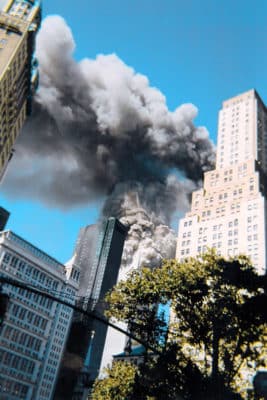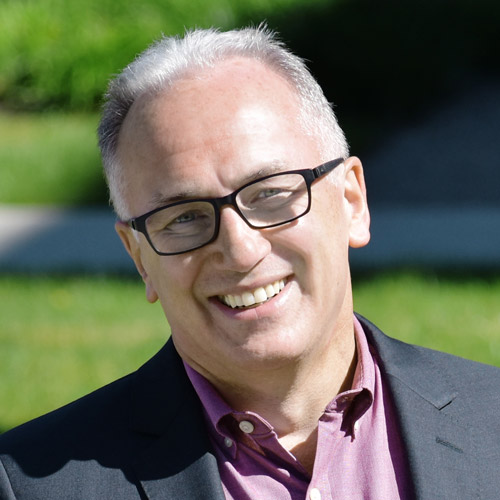
In Alan Di Sciullo’s mind, things were looking good.
Sure, he’d had an early morning doctor’s appointment that day, which was delaying him a little bit, but as he rode the PATH train that connects New Jersey and New York, he felt confident he would make it to his office in time to dial into the 9:00 a.m. conference call to Morgan Stanley’s legal colleagues.
Then, the train stopped. Passengers were instructed to go to another platform to take a different train into the city. Di Sciullo boarded, and when it got to his stop a few minutes after 9:00 a.m., he looked at his watch. Although he was going to be a little late, he was still fully intent on getting up to his office and dialing into the conference call.
Then, he looked up.
“I saw what could only be a bad movie,” he says.
It was the morning of September 11, 2001. Tower 1 of the World Trade Center was on fire. Di Sciullo took a few more steps and looked up at Tower 2, which housed his Morgan Stanley law department offices on the 65th floor. Fire also burned fiercely there. Di Sciullo watched in shock for about half an hour, until someone nearby shouted that the building was collapsing. Di Sciullo ran toward City Hall, and although he saw people emerging from the clouds of ash and debris crying, he says he and other survivors went into the clouds to help.
“Instead of panic, I saw the same spirit of cooperation and assistance I witnessed when we evacuated the upper floors of the World Trade Center when it was bombed in 1993,” he says.
Di Sciullo says it’s hard to estimate how many employees were in the Morgan Stanley offices that day, given that the attacks happened before many people (including himself) had arrived in the office. But, out of the estimated 2,500 employees of the firm that worked in the World Trade Center, there were only 13 fatalities of staff and consultants.
One of those was Rick Rescorla, a lawyer and Vietnam War veteran who had headed the company’s security department. Rick and his security colleagues went back into the tower to pull as many people as possible to safety before the building collapsed. Unfortunately, when it did, Rescorla was still in it.
“I can’t think of a more down-to-earth guy or a more lovable person than Rick,” Di Sciullo says. “He was our hero—even before that day.”
In addition to processing the shock of the events and the loss of its team members, Morgan Stanley also had to deal with the reality that it had lost its home. Before the attacks, Morgan Stanley had 1.2 million square feet of space in the World Trade Center under lease. Just a few hours later, it had zero. Di Sciullo had to get to work immediately, working with a team to find and legally secure new office space for Morgan Stanley employees, who had made up the largest tenant roster at the World Trade Center.
By the afternoon on the day of the attack, the firm was rebuilding. Di Sciullo found that the same sense of camaraderie and cooperation he’d witnessed at Ground Zero also made its way into negotiations. Although the weakened real estate market provided plenty of space throughout Manhattan, the properties Morgan Stanley ultimately acquired—a total of 600,000 square feet throughout various locations—came without difficult negotiations and, in some cases, at an incredible price.
“In one instance, I was dealing with an attorney who was known as this tough New York lawyer,” Di Sciullo recalls. “But he told me, ‘We’ll go straight down the middle on this. No negotiating ploys, no delays, let’s get this deal done.’ That was a godsend.”
“In another instance,” he adds, “I was dealing with an attorney who works in Chicago, and I said, ‘How much is this space going to be?’ She said, ‘Ten dollars.’ The market there was $50 or $60 per square foot. I said, ‘Ten dollars? Is that in square feet?’ She said, ‘No, we do legal consideration at $10, and we enter into this agreement. It’s a legal technicality we learned.’ I mean, we’re talking 3,000 square feet in midtown New York for a few years for only ten dollars. There were little things like that happening. People went out of their way.”
In his role today, as New York-based Shearman & Sterling LLP’s director of global real estate, Di Sciullo leads a small but experienced team that works across international borders, securing a variety of properties for clients with a work ethic tied to always securing the best deal possible. And despite some of the crises that might present themselves—understanding foreign regulations, weathering new standards in the midst of a major renovation, or finding the best property available in a highly competitive market, among others—Di Sciullo says he maintains a unique perspective on them, shaped by that fateful day in New York City 17 years ago.
“Being able to work through something like that allows you to say there’s no crisis in your career that will be that bad,” he says. “I’ll say it to my staff. We’ll have an HVAC problem in one place and something else to deal with somewhere else. I tell them, ‘We’ll do it.’ It’s instinctive. That day in 2001, no one panicked or melted down. People were very proactive right from the start. I carry that with me.”
 Connecting Deep
Connecting Deep
Prior to starting with Morgan Stanley, Alan Di Sciullo had an opportunity to host an event at the Sheraton Hotel with Pro Football Hall of Famer Roger Staubach, who was starting his own realty company.
After the event, Staubach gifted Di Sciullo with an autographed football that he proudly displayed in his World Trade Center office—and that was lost on the morning of September 11, 2001.
On the afternoon of September 11, Di Sciullo was on the phone with Morgan Stanley’s West Coast real estate manager, who remained in touch with Staubach. After Di Sciullo relayed that most of the Morgan Stanley employees were OK and that the company was already at work finding new space, the real estate manager asked him about personal items lost in the collapse. He mentioned the football.
“Three months later, I’m on a business trip,” Di Sciullo says. “I called my secretary, who told me I’d received a box at the office.”
The box contained a new autographed football from the Dallas Cowboys legend—as well as a small note thanking him for his bravery on September 11. Touched, Di Sciullo called the West Coast real estate manager to relay his thanks to Staubach.
“She said, ‘Oh yeah, he said he was going to do that. What did it look like?’” he says. “I told her, ‘Oh it’s beautiful. It’s got this nice white panel on it.’ Then I hear her go, ‘Damn it! Those are his nicest ones. He’s never given me one like that!’”
Photo: Alan Di Sciullo
CBRE congratulates Alan Di Sciullo on his accomplished career as Shearman & Sterling’s director of global real estate. A Fortune 500 and S&P 500 company, CBRE is the world’s largest commercial real estate services firm, with more than 75,000 employees serving real estate investors and occupiers through 450 offices worldwide. From investment sales and leasing transactions to outsourcing and advisory services, CBRE delivers advantage for every client it serves. Visit us at http://www.cbre.us/
 Connecting Deep
Connecting Deep

